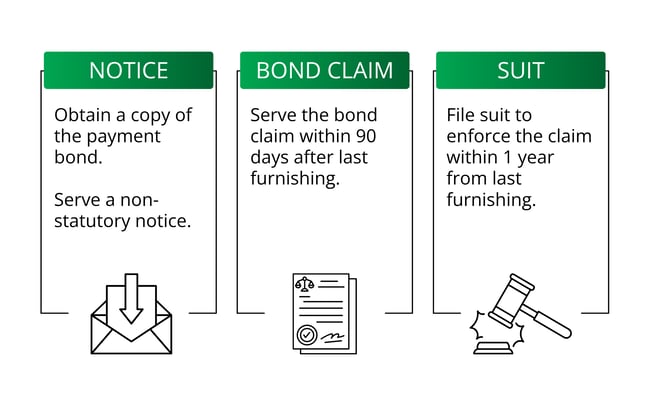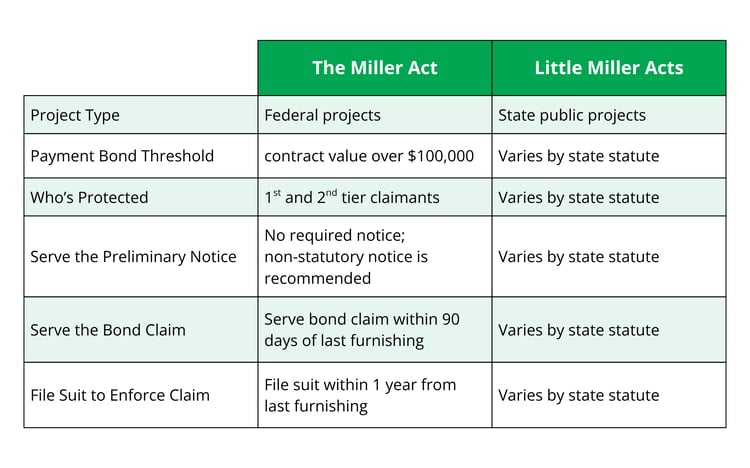Payment Bonds vs. Performance Bonds
Payment Bonds vs. Performance Bonds In this corner we have an $8.4 million bond, created & executed to protect you in the event the principal does...

In 1935, the federal government created the Miller Act statute, requiring prime contractors to obtain a payment bond on any United States Government contract over a certain threshold.
This law affords great protection to those who provide labor or materials to the prime contractor or its subcontractors on federal projects. With payment bond requirements for prime contractors and the ability for claimants to enforce claims against the payment bond, it deters non-payment.
All those who provide labor and/or materials used in the prosecution of the work, to the prime contractor or first-tier subcontractor, are covered. Note: Those providing only materials to a material supplier are not protected by The Miller Act. Those furnishing to second-tier subcontractors are also too far removed to have rights under The Miller Act. 
Yes, rights can be waived. However, according to 3133. Rights of persons furnishing labor or material, the waiver must be in writing, and it can’t be executed until after the claimant has completed furnishing.
No preliminary notice is required at the start of the federal project. However, a non-statutory notice is recommended so the prime contractor knows you will be protecting your rights.
For those who have furnished labor or materials to a federal project, and have not been paid, the bond claim should be served after your last furnishing, but within 90 days from your last furnishing. If serving the bond claim does not prompt payment, file suit to enforce the Miller Act Bond Claim in U.S. District Court after 90 days from last furnishing materials or services, but within 1 year from last furnishing materials or services.

The statute for federal projects is relatively straightforward and applies to all states; meaning unlike state statutes which vary, federal statute is the same across the board. U.S. Federal projects in foreign lands may also fall under the protection of the Miller Act.
No, tribal land is sovereign and doesn’t fall under federal jurisdiction. We recommend proceeding with a non-statutory bond claim against the general contractor’s payment bond, along with pursuing the debtor (filing suit if necessary).
Another option could be the filing of a UCC-1. Of course, the UCC filing would need to be done before supplying materials to your customer, so that decision would have to be made at the time of contract.
The Miller Act is the federal statute that requires payment and performance bonds on certain federal construction projects. Every state has its own version (based on the Federal Miller Act), commonly called a “Little Miller Act.” While they serve the same purpose, protecting subcontractors, suppliers, and laborers on public projects where mechanic’s liens are not allowed, there are important differences.

(Note: a federally funded project doesn’t mean it’s a federal project.)

Payment Bonds vs. Performance Bonds In this corner we have an $8.4 million bond, created & executed to protect you in the event the principal does...

Which Bond is Which? Bond Types in Construction Credit: a Bond Breakdown The construction credit world is chock full of industry-specific terms and...

Are You ‘OK’ with Oklahoma’s Mechanic’s Lien & Bond Claim Requirements? Furnishing to a construction project in the Sooner State? Today’s quick read...